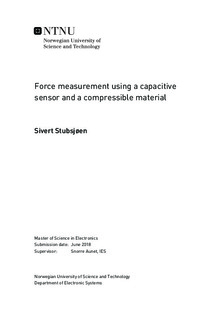Force measurement using a capacitive sensor and a compressible material
Master thesis
Permanent lenke
http://hdl.handle.net/11250/2565280Utgivelsesdato
2018Metadata
Vis full innførselSamlinger
Sammendrag
Disruptive Technologies are developing sensor solutions for the Internet of Things. Their current sensors can measure touch, temperature, and proximity. To expand the area of applications their current sensors cover, new sensor solutions are examined. The one studied in this thesis is a capacitive sensor measuring force. The idea is to place a compressible material on the front of Disruptive Technologies capacitive proximity sensor and use it to measure force. A compression of the material would lead to an increased capacitance measured.
This thesis covers the work of finding suitable materials and the practical measurements doneto characterize the capacitive sensor and the compressible material. Testing was done at twodifferent materials that had properties useful for the intended application. These tests revealed that neither of the materials was optimal for a solution as described above. For different series of measurements, the values measured by the sensor variated for the same applied load. This made the work of creating a good fitting data model difficult. The proposed models could not predict with high probability the values measured by the sensor for the various applied loads.
This lead to the conclusion that either the materials or the chosen sensor solution was not the optimal one for measuring force. As a result of this, two other force sensing methods using the same sensor is presented that can be further investigated in future work.
